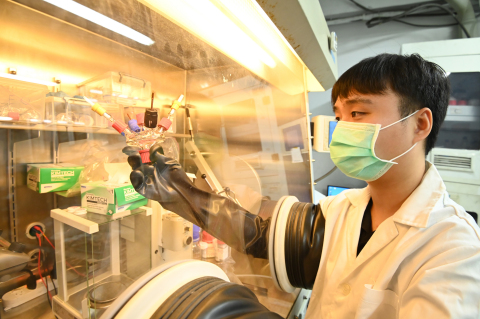Gezamenlijk Tsinghua-Liverpool onderzoeksteam ontdekt nieuw lading opslagmechanisme
HSINCHU, Taiwan–(BUSINESS WIRE)– Vanwege hun hoge energiedichtheid en lage kosten zijn metaal-luchtbatterijen een van de meest veelbelovende energiebronnen van de toekomst. Een gezamenlijk onderzoeksteam van Tsinghua-Liverpool heeft onlangs een nieuw lading opslagmechanisme ontwikkeld dat oplaadbaarheid in calcium-luchtbatterijen mogelijk maakt – een grote stap voorwaarts in batterijtechnologie.
Dit persbericht bevat multimedia. Bekijk de volledige release hier: https://www.businesswire.com/news/home/20210816005031/en/
Lu in het laboratorium van Prof Hu, waar hij experimenten opzette om de resultaten van NTHU en UoL te vergelijken.
Deze ontdekking is gepubliceerd in Chemical Science. De hoofdauteur van het artikel, Yi-Ting Lu, is een gezamenlijke doctoraatsstudent aan Tsinghua en Liverpool, wiens supervisors Prof. Chi-Chang Hu (Department of Chemical Engineering, NTHU) en Prof. Laurence Hardwick (Department of Chemistry, UoL zijn).
Joint Tsinghua-Liverpool Research Team Discover New Charge Storage Mechanism
HSINCHU, Taiwan–(BUSINESS WIRE)– Due to their high energy density and low cost, metal-air batteries are one of the most promising power sources of the future. A joint Tsinghua-Liverpool research team has recently developed a new charge storage mechanism that allows rechargeability within calcium-air batteries – a major step forward in battery technology.
This press release features multimedia. View the full release here: https://www.businesswire.com/news/home/20210816005031/en/

Lu in Prof Hu’s lab where he set up experiments to cross compare results obtained at NTHU and at UoL.(Photo: National Tsing Hua University)
This discovery has been published in Chemical Science. The lead author of the paper, Yi-Ting Lu, is a joint doctoral student at Tsinghua and Liverpool, whose supervisors are Prof. Chi-Chang Hu (Department of Chemical Engineering, NTHU) and Prof. Laurence Hardwick (Department of Chemistry, UoL).
A major breakthrough related to Ca-air batteries
Prof. Hu said conventional lithium-ion batteries have a limited practical capacity. Thereby many researchers are working on developing alternative battery technologies. Their focus is on metal-air batteries based on zinc, lithium, sodium, potassium, calcium, magnesium, and aluminum. The advantage of the calcium-air battery is its high specific energy—five times that of traditional lithium-ion batteries. However, the feasibility of calcium-air batteries remains hampered by one major drawback—it cannot be recharged.
Lu explained that metal-air batteries are electrochemical cells usually using an active metal as the negative electrode, and a porous carbon material in contact with the air as the positive electrode. When the metal oxidized the oxygen at the positive electrode is reduced, generating electric current.
After completing his first year of doctoral studies at NTHU, Lu enrolled at the Stephenson Institute for Renewable Energy at UoL in September 2018. Under the supervision of Prof. Hardwick, he began doing research on the electrolyte used in calcium-air batteries.
Lu found when a single electrode is repeatedly charged and discharged, initially no reversibility can be observed, but after a few dozen cycles it gradually displays some reversibility. Surprisingly, the result seemed completely different from those in literature. The research team conducted a series of experiments aimed at uncovering the mechanism behind this phenomenon. On the electrode surface, the discharge products form a calcium oxide (CaxOy) interlayer, where the discharge product of oxygen, known as superoxide, is confined, allowing the superoxide to be then readily oxidized. This suggests the oxygen could probably be repeatedly oxidized/reduced, so that the cell can be continuously discharged/recharged.
Dr. Alex Neale, a Liverpool postdoctoral researcher, who is also part of the research team, said that through systematic electrochemical and spectroscopy investigations, the team began to understand the origins of this charge storage mechanism that facilitates a previously unseen degree of reversibility for systems based on the calcium-air battery.
Prof. Hardwick said the team will focus on designing new battery systems that use this newly discovered charge storage mechanism. He added that it was the cooperative research that made their discovery possible, and there are plans for even closer cooperation between NTHU and UoL in the future.
View source version on businesswire.com: https://www.businesswire.com/news/home/20210816005031/en/
Contacts
Holly Hsueh
NTHU
(886)3-5162006

